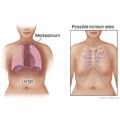Health Library
We have a vast digital library of medical information, including wellness and psychiatry topics as well as general medical topics. For more information or to schedule an appointment, don’t hesitate to call us.
Our Health Library information does not replace the advice of a doctor. Please be advised that this information is made available to assist our patients to learn more about their health. Our providers may not see and/or treat all topics found herein. Mediastinoscopy (say "mee-dee-yass-tuh-NAW-skuh-pee") is a procedure that looks at the space behind your breastbone and between your lungs. This area is called the mediastinum (say "mee-dee-ya-STY-num"). During the procedure, a small cut (incision) is made in the neck just above the breastbone or on the left side of the chest next to the breastbone. Then a thin lighted scope (mediastinoscope) is inserted through the incision. The scope lets the doctor look around inside that space. This procedure is done to look for problems such as infection, inflammation, or cancer. A tissue sample (biopsy) can be collected through the scope. The sample can be examined under a microscope for problems. This procedure usually takes about an hour. This procedure is done to: Procedures can be stressful. This information will help you understand what you can expect. And it will help you safely prepare for your procedure. A small cut (incision) is made in the neck just above the breastbone or on the left side of the chest next to the breastbone. Then a thin scope (mediastinoscope) is inserted through the opening. Your doctor will look at the space in your chest between your lungs and heart. Lymph nodes or a tissue sample (biopsy) can be collected through the scope. The sample is then examined under a microscope for problems. These may include infection, inflammation, or cancer. After the scope is taken out, the incision will be closed with a few stitches and covered with a bandage. After the procedure, you will be taken to the recovery room. You may feel sleepy for several hours but can usually go home the same day. The entire procedure usually takes about an hour. Before the procedure, you may be given medicine to relax you. You will then get general anesthesia, which will make you sleep. Problems from mediastinoscopy aren't common. But they may include bleeding, infection, a collapsed lung, a tear in the esophagus, damage to a blood vessel, or injury to a nerve near the voice box (larynx) which may cause hoarseness. Current as of: September 29, 2025 Author: Ignite Healthwise, LLC Staff Current as of: September 29, 2025 Author: Ignite Healthwise, LLC Staff Clinical Review Board This information does not replace the advice of a doctor. Ignite Healthwise, LLC disclaims any warranty or liability for your use of this information. Your use of this information means that you agree to the Terms of Use and Privacy Policy. Learn how we develop our content. To learn more about Ignite Healthwise, LLC, visit webmdignite.com. © 2024-2025 Ignite Healthwise, LLC.Mediastinoscopy
Why It Is Done
How To Prepare
Preparing for the procedure
How It Is Done
How long the test takes
How It Feels
Risks
Results
Normal
Abnormal
Related Information
Credits
Clinical Review Board
All Ignite Healthwise, LLC education is reviewed by a team that includes physicians, nurses, advanced practitioners, registered dieticians, and other healthcare professionals.
All Ignite Healthwise, LLC education is reviewed by a team that includes physicians, nurses, advanced practitioners, registered dieticians, and other healthcare professionals.





